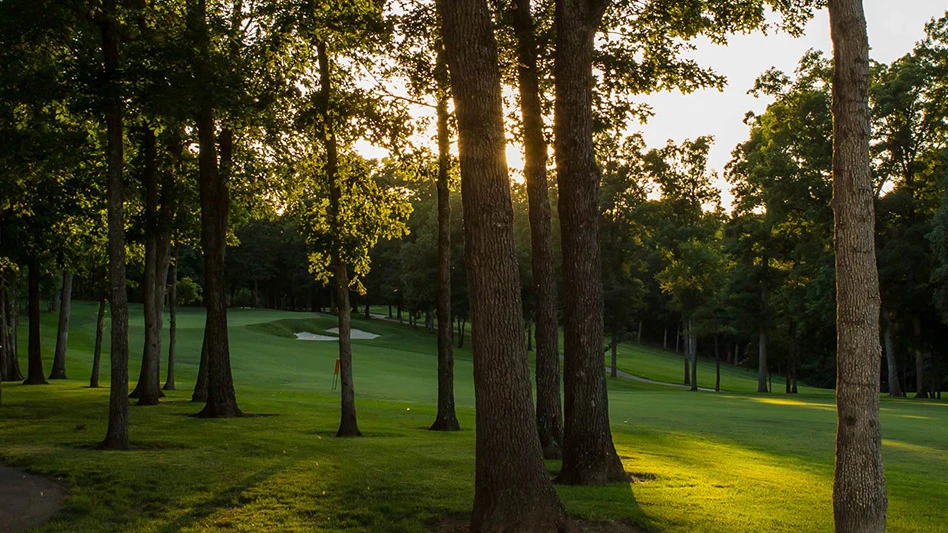
 |
A superintendent, architect, contractor and shaper gathered on the balcony of a stately Southwest Florida clubhouse one evening last month and encountered a major test to their collective humility.
Member after member lauded their work on The Oaks Club’s Heron Course. In a segment of the industry where high-level performers often shun attention and focus on the next task, a rare chance to reflect on what the group accomplished emerged after members left the celebration.
Working near homeowner’s backyards through storms and brutal humidity within the confines of deadlines and budgets, multiple parties combined to deliver what they promised to the membership. The Heron Course, once considered by numerous members the weaker of The Oaks Club’s two courses, has developed into an immense source of pride.
“Hearing the comments is one thing, but seeing it is another,” director of green and grounds Nick Kearns says. “When I look at the tee sheet on a regular basis, the Eagle Course used to be 60 percent of the play, if not a bit higher. That has definitely started to transition over the Heron. That in of itself says a lot.”
 |
The renovations undoubtedly benefit Kearns and his staff, as the club purchased a new irrigation system with 350 added sprinklers to improve efficiency. The bunkers – arguably the most visually defining part of architect Jason Straka’s redesign – went from flat- to flash-faced and they were constructed using the Better Billy Bunker system. Kearns, though, says the new bunkers use a cumulative one acre less of sand than the previous bunkers. Improved bunker construction and water flow throughout the course mean a better chance of keeping play on schedule following a Florida dousing.
Straka devised a teeing system that considers players of all skill levels, with the forward tees now measuring 4,185 yards. Straka also reduced the number of nettlesome forced carries by creating open entries to greens. Fun and imaginative are two words that immediately come to mind when touring the course. Even a 10-handicapper from the North needs only one sleeve of Titleists to make it through the Heron in January.
And what’s a major renovation without improved turgrasses? Members are putting on TifEagle greens and hitting from Celebration fairways and TifGrand approaches.
Kearns, Straka, Southeastern Golf’s Chuck Baker and shaper Justin Carlton offere clues of how to appease members in this new era of big renovations, many of which seem to be occurring in Florida.
The Heron Course opened in the early 1980s and experienced slight modifications in the early 2000s. The course was built before surrounding homesites, a common practice in Florida golf course communities. The construction approach meant dirt collected in the middle of the property and water rested alongside the course in big troughs.
“The water would sit,” Straka says. “There was no drainage in a lot of instances. And then they built the houses. Not only did it create drainage problems, but from a playability standpoint it was what I call rejection golf. You would hit it toward the out of bounds and things would kick into hazards or out of bounds. It became very, very difficult.”
Selling the need to improve drainage provide easy. The course residents knew what they were getting. The tricky part came when members started asking why they couldn’t improve specific areas of the course such as drainage and irrigation in phases. “This wasn’t a project where that could take place,” Kearns says. “It needed to be all or nothing or otherwise you were wasting a lot of money.”
A major key to the project’s overall success involved explaining to members that catch basins and drain tiles alone don’t solve longstanding drainage problems, Straka says. Southeastern Golf representatives toured the property before submitting a bid and immediately understood the existing infrastructure challenges.
“You can have pipe and basins, but you have to move water,” Baker says. “You have to move water a lot differently than what was here. Those low points have a function. It’s not just moving water to drains. You are trying to play golf. You don’t put basins wherever you can. It’s still a golf course. You have landing areas and you don’t have basins in the middle of landing areas. You don’t have basins just to catch water. They have to strategically be where they need to be.”
Members approved the renovation in late 2013. Construction started in mid-2014 and work was completed last fall. A large portion of the work was completed in the summer, when many residents flock to their northern homes. Communication to the membership was established via a blog. And with the help of a club-purchased drone, Kearns provided overhead views of the progress. Tours were also available to members.
Without frequent and clear communication, the renovation had the potential to cause lingering problems. The Oaks Club has 795 homesites. Changing somebody’s golf course is one thing. Changing the area surrounding a home is a much more delicate process.
“You are not only designing a golf course, you are designing a landscape,” Straka says. “It was a massive renovation, but it was a renovation. It wasn’t like you were building a course and people were buying their view. Change becomes very difficult for a lot of people. It’s a well-established club and people have successful lives.”
The construction team, which included Joe Voss, a project manager hired by the club, knew an enhanced product awaited because of past experiences with similar projects. Member angst caused by the dirt moving steadily decreased as the improvements started becoming noticeable.
“Starting off the clearing had to take place,” Kearns says. “That was a very difficult thing for the homeowners and members to see. Now that they are playing the actual product and seeing what’s happened they have appreciated it more, especially toward the later third of the project they understood what actually took place and how it’s going to benefit the golf course.”
Work was completed within budget and on schedule, and club officials are confident the renovation will help The Oaks Club in the crowded Southwest Florida golf/residential marketplace. Director of membership and marketing Susan Greene announced at a January event attended by select industry publications the club has a waiting list for memberships. The ground game created on the Heron Course gives the club a contrasting option to the Eagle Course, where Straka says lob shots around greens are the norm.
Guy Cipriano is GCI’s assistant editor.
Latest from Golf Course Industry
- 2025 Super Social Media Awards: Brent Downs
- Reel Turf Techs: Ron McCall
- TerraRad receives strategic investment from Old Tom Capital
- Beyond the Page 63: A different approach to labor
- 2025 Super Social Media Awards: Joshua Kelley
- Spanish Bay set for 2026-27 renovation
- An updated Iowa classic turns to Troon
- Introducing our January 2025 issue





